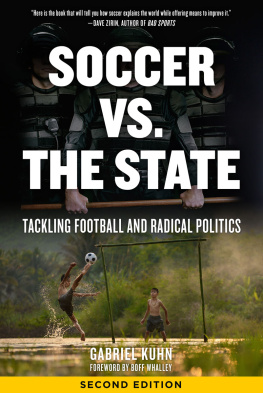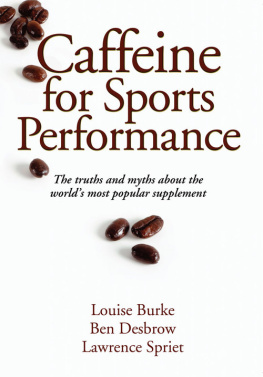The iconic clenched-fist salute offered up by African-American athletes Tommie Smith and John Carlos during their medal ceremony at the 1968 Olympics in Mexico City did not occur in isolationit came in the spirit of similar protest actions at sports events, all around the world. In Playing as if the World Mattered, the reader discovers in brilliant detail what has been true all along: that sports has always been more than a game.
Sam Tracy, author of Bicycle! A Repair & Maintenance Manifesto
Sport as politics, particularly radical resistance against tyranny, is an exciting and crucial part of our history. It amazes me that it has taken so long for this story to be told. It is intensely fascinating and academically scrupulous. What an addition to the worlds understanding of one of our great passions!
Meredith Burgmann, former president of the Australian Council for International Development
Gabriel Kuhn has shown again that, contrary to whatever FIFA or the IOC might say, sport and politics are not only keen bedfellows but have enjoyed a long and lusty partnership.
Will Simpson, author of Freedom Through Football: The Story of the Easton Cowboys and Cowgirls
Gabriel Kuhn is not concerned with moral reflections about how to approach sports and politics. Instead, he provides practical examples of how sport is already politicized and portrays supportersand even athletesas progressive social forces.
Ekim alar, Flamman
Creativity and solidarity are as indispensable in sport as they are in social struggle. If you have any doubt, read this book.
Wally Rosell, editor of loge de la passe: changer le sport pour changer le monde

Drawing by Nria Frago ( nuriafrago.wordpress.com ).
Playing as if the World Mattered: An Illustrated History of Activism in Sports Gabriel Kuhn
2015 PM Press.
All rights reserved. No part of this book may be transmitted by any means without permission in writing from the publisher.
ISBN: 9781629630977
Library of Congress Control Number: 2015930879
Cover by John Yates / www.stealworks.com
Interior design by briandesign
10 9 8 7 6 5 4 3 2 1
PM Press
PO Box 23912
Oakland, CA 94623
www.pmpress.org
Printed in the USA by the Employee Owners of Thomson-Shore in Dexter, Michigan.
www.thomsonshore.com
Contents

All movements are resistance. Print by Dylan Miner ( www.dylanminer.com ).
Introduction

Exhibition A Womans Place Is by FC United of Manchester (see ), 2013. Photograph by Mark Van Spall.
W hile sport has received increased attention within the political left in recent yearsnot least in connection with an increased interest in popular culture in generalanti-sport prejudices remain. The prominent Marxist Terry Eagleton has stated that it is sport, not religion, which is now the opium of the people (in The Meaning of Life), while, in the anti-sport treatise Barbaric Sport: A Global Plague, Marc Perelman declares that in the pestilential environment oozing out of sport, the question arises: what can critical theory come up with today against sport now it has become the visible face of every society? The only possible critical response is a firm assertion: there should be no sport.
It is easy to criticize sport from a left-wing perspective. There is plenty of bigotry and machismo. The global administration of sport reflects Eurocentrism and (neo)colonialism. Commercialism and celebrity cults run amok. Sport is tied into the worst kinds of nationalism and chauvinism. Competitiveness, perhaps the most crucial ingredient of a capitalist culture, often becomes most tangible in sport. Sport is used for political propaganda, sometimes by the most unsavory of politicians. Sport contributes, perhaps ironically, to unhealthy ideals of fitness and beauty, and millions of kids go through traumatic experiences during physical education. It is also true that sport does serve as an opiate for the masses. Yet, how much of all this depends on sport, and how much on the social and cultural circumstances sports are played in today?
This book is not about reclaiming some supposedly genuine leftist value in sport, buried by capitalist alienation. Sport is a combination of thingsexercise, play, catharsis, and morethat arent tied to any particular political brand or value system. Sports political meaning is created by the way it is exercised, and by the social place it occupies. This, however, challenges us to take sport seriously and to create circumstances that bring out the best in it, not the worst. Perhaps most importantly, sport wont go anywhere. People will want to exercise, play, and release their emotions in the most free and egalitarian of societies. Besides, sport occupies the minds and hearts of many more people than radical caucuses or anticapitalist debates do. To brush this aside as a mere matter of brainwashing is dangerously patronizing.

Advertisement by the German socialist daily junge welt. The quote reads: The revolution is greatoffside is bunk. Courtesy of junge welt ( www.jungewelt.de ).
As much as we need to create liberated forms of economic production and distribution, political decision-making, scientific research, and artistic expression, we need to create a world of sports that fits the picture. The guiding principles are comradeship, fair play, empowerment, social learning, and community. People have followed these principles and tried to create corresponding environments since the inception of organized sports in the late nineteenth century. Some chapters of this history are fairly well known, for example Muhammad Alis refusal to serve in Vietnam or the clenched-fist salute Tommie Smith and John Carlos offered at the 1968 Mexico Olympics; others are almost forgotten, such as the workers sports movement of the early twentieth century; and some have always lingered underground, like the worldwide web of grassroots and community sports clubs. This book aims at unearthing these chapters of sports culture for a better understanding of the struggle for both better sports and a better world.
As suggested by the books title, images will play a major role in telling the relevant stories. This follows the simple truth that an image can say more than a thousand words. The fact that the accompanying texts are kept short is the result of basic economic calculations: producing a full-color book that is reasonably priced demands a limit in size. However, each section has a listing of publications, films, websites, and other resources that allow the reader to dig deeper into areas of particular interest.

Election poster by the Swedish Communist Party, 1944: A straight left knocks out the right. Vote with the Communists! Courtesy of Arbetarrrelsens arkiv och bibliotek, Stockholm, Sweden ( www.arbark.se ). Artist: Nils Brdefors.
Next page




















